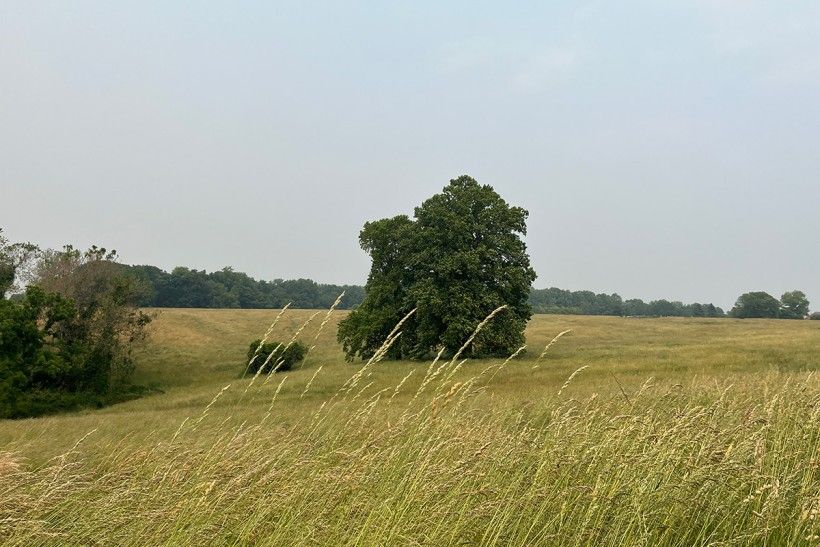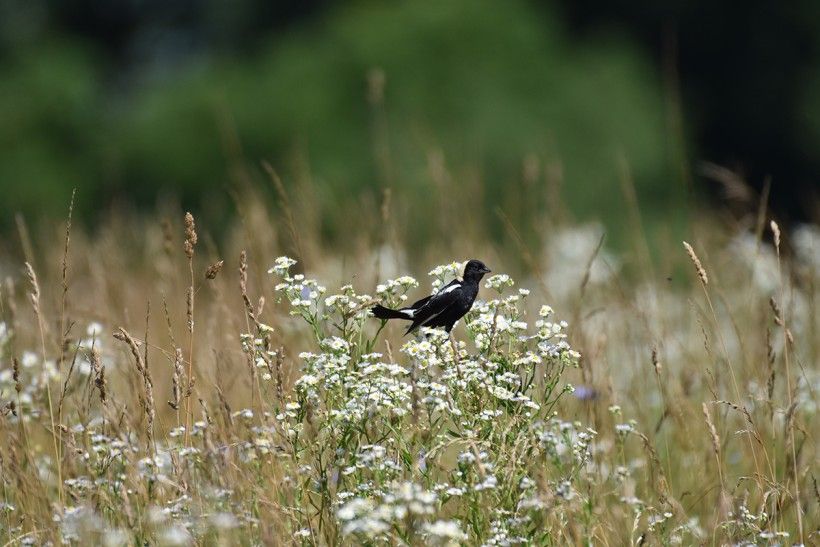Piedmont Spotlight: Grasslands, Meadows, and Savannas

Join us as we continue our exploration of the vegetative communities of the Piedmont region of the Eastern United States. In this ongoing series of blogs, we will spotlight specific vegetative communities, define their historic structures, describe the processes that created them, examine past and ongoing threats to their survival, and provide suggestions for long-term, sustainable management to help steward them into the future.
Prior to European colonization, grasslands, meadows, and savannas (“GMS” communities) made up a small percentage of land cover in the Piedmont, a region primarily dominated by forest. Today, that percentage is higher due to the number of crop fields, lawns, hayfields, pastures, and fallow fields. However, these modern grassland communities are often considered to be ecological sinks or even ecological traps which fail to provide quality habitat for the wildlife that rely on them.
New and remnant GMS communities also continue to decrease in size due to conversion through development and ecological succession. The Pennsylvania Natural Heritage Program describes three terrestrial grassland community types that naturally occur in the Piedmont today. These are “Little bluestem – Pennsylvania sedge openings,” “Side-oats gramma calcareous grasslands,” and “Serpentine grasslands,” which are part of serpentine barrens complexes. In this article, we will focus on the former two GMS communities, describe the extent of GMS communities preceding European settlement, and offer some suggestions for restoration and reclamation of GMS communities today.
History and Composition
Though deciduous forests have long dominated the eastern United States, grasslands, meadows, and savannas have coexisted as small but important vegetative communities. These communities, by their nature, are generally unstable, and if left unimpeded, succeed to the forests that surround them. Some outliers, such as the Pocono till barrens and the Serpentine barrens, survive as self-perpetuating systems, but only a set of unique circumstances involving soil composition, topography, and nutrient cycling makes this possible.

By and large, an absence of high-intensity disturbances guarantees woody vegetation domination of GMS systems. Historically, these high-intensity disturbances included intense grazing and intense fires. Native American populations used the latter to produce desirable forage for herbivores and promote the former. These disturbances eliminated woody vegetation and, in some spots, all vegetation, creating varied site conditions resulting in irregular plant colonization (meaning a variety of species could inhabit the same opening at a variety of densities). This great diversity is what makes healthy GMS communities such powerhouses of biodiversity.
In the Piedmont, there is historical precedence for two broad GMS communities: serpentine grasslands and savannas and Piedmont Triassic lowland mesic diabase meadows. Serpentine complexes, as we’ve previously discussed, occur in an arc stretching from northern Baltimore County through southern Chester and Lancaster Counties and up into central Delaware County. The Piedmont Triassic lowland is an ecoregion that covers northeastern Chester County and almost all of Montgomery and Bucks Counties. Valley Forge provides a good example of the meadows found in this ecoregion. The Pennsylvania Natural Heritage Program lists three non-serpentine community types that fit the description of terrestrial GMS communities. Two of these, “Little bluestem – Pennsylvania sedge openings” and “Side-oats grama calcareous grasslands,” are grasslands, while the third, “Red-cedar – redbud shrubland,” could be considered a savanna under the right conditions.

Grasslands, by definition, consist of only an “understory” layer and have few if any woody species. According to PNHP, the understory of the “Little bluestem – Pennsylvania sedge opening” is dominated by little bluestem (Schizachyrium scoparium), Pennsylvania sedge (Carex pensylvanica), poverty grass (Danthonia spicata), common hairgrass (Deschampsia flexuosa), C. communis (a sedge), prickly dewberry (Rubus flagellaris), bush-clovers (Lespedeza spp.), and less commonly, slender mountain ricegrass (Piptatherum pungens, a Pennsylvania endangered species that is found on sites in the northeastern part of the state). Mosses and lichens, especially reindeer lichens (Cladonia spp. and Cladina spp.), and hairy-cap mosses (Polytrichum spp.) are also abundant on some sites. “Little bluestem – Pennsylvania sedge openings” are found on dry-mesic to xeric sites where moisture is very limited with acidic, thin, sandstone-derived soils that are nutrient-poor.
“Side-oats grama calcareous grasslands” are dominated by side-oats grama (Bouteloua curtipendula, a Pennsylvania threatened species), big bluestem (Andropogon gerardii), Indian grass (Sorghastrum nutans), switchgrass (Panicum virgatum), little bluestem (Schizachyrium scoparium), Pennsylvania sedge (Carex pensylvanica), bush clovers (Lespedeza spp.), tick-trefoil (Desmodium spp.), whorled milkweed (Asclepias verticillata, a Pennsylvania threatened species), green milkweed (A. viridiflora), false gromwell (Lithospermum parviflorum), roundleaf groundsel (Packera obovata), hoary pucccoon (Lithospermum canescens, a Pennsylvania threatened species), and silver-rod (Solidago bicolor). They also have some typical woody species which may occur scattered throughout or at margins of the site and include redbud (Cercis canadensis), dwarf hackberry (Celtis tenuifolia), red-cedar (Juniperus virginiana), white ash (Fraxinus americana), chinkapin oak (Quercus muhlenbergii), hop-hornbeam (Ostrya virginiana), flowering dogwood (Cornus florida), smooth sumac (Rhus glabra), fragrant sumac (Rhus aromatica), and downy arrow-wood (Viburnum rafinesquianum). “Side-oats grama calcareous grasslands” are found on dry-mesic sites where moisture is moderately limited, calcareous soils that are basic and nutrient-poor.
Savannahs are defined by Latham and Thorne as sites “dominated by either grasses or forbs with sparse, scattered trees or tall shrubs (between 5% and 25% canopy cover). “Red-cedar – redbud shrublands” also occur on dry-mesic sites with calcareous soils, though moisture is not as limited as it is on “Side-oats grama calcareous grassland” sites. Characteristic woody species include red-cedar (Juniperus virginiana) and eastern redbud (Cercis canadensis). Other woody species present include hop-hornbeam (Ostrya virginiana), shadbush/serviceberry (Amelanchier spp.), fragrant sumac (Rhus aromatica), and flowering dogwood (Cornus florida). Characteristic herbaceous species include side-oats grama (Bouteloua curtipendula), big bluestem (Andropogon gerardii), switchgrass (Panicum virgatum), Indian grass (Sorghastrum nutans), aromatic aster (Aster oblongifolius), American gromwell (Lithospermum latifolium), and wild columbine (Aquilegia canadensis).
These three community types are the only ones described by PNHP’s field studies, and the individual instances of each are typically quite small and not the sprawling seas of green we might imagine when thinking of grasslands, meadows, or savannas. As we mentioned, though, there were many GMS communities that predated European settlement. It is estimated that between 147,200 and 153,600 acres of grasslands, meadows, and savannas covered Pennsylvania at the time of European settlement; now, only approximately 640 acres of those same historic communities remain today. These historic GMS communities are particularly valuable because of the diversity of plant and wildlife species that they support as well as the model that they provide for pre-settlement community structure. Unfortunately, these, along with other non-historic GMS communities, face challenges similar to those of the serpentine barrens communities.

Threats/Challenges
Like serpentine barrens communities, grasslands, meadows, and savannas in Pennsylvania face two primary threats: land conversion through development and vegetative community conversion through improper management. If we count agricultural fields, both active and fallow, as a form of GMS community, these are the first to be developed as part of urban sprawl. For those GMS sites that remain undeveloped, inadequate management can result in either domination of the site by non-native species or succession of the site to woodland or forest.
A “hands-off” approach will result in rapid colonization, likely by several invasive species such as multiflora rose or autumn olive, after which point returning the site to its previous condition will be costly and take time. Routine mowing, while effective in suppressing woody species, will not result in the variable site conditions created by fires or grazing in natural scenarios. This will reduce the quality of wildlife habitat provided by the community and restrict the number of species that can use it.
Additionally, certain farming practices might further impede a working GMS site’s ability to double as wildlife habitat. Hedgerows, for instance, create additional edge habitat and disrupt interior, large grasslands. Certain species of birds, such as bobolinks and Henslow’s sparrows, require large (at least 75 acres), contiguous patches of grassland to survive. Most hayfields and pastures also consist of non-native cool-season grasses. Though many of these species have become naturalized, they still fail to provide the ecosystem services that wildlife species adapted for these habitats rely on.
Finally, mismanagement of GMS communities can result in the accidental creation of ecological traps. Ecological traps are wildlife habitats that, though preferred by wildlife over other habitats, ultimately provide lower habitat quality and ultimately lead to a net decrease in the population. Hayfields are often ecological traps for grassland-nesting birds. These sites are attractive for breeding birds, but due to early mowing, many nests and breeding pairs are destroyed.

Opportunities
Small landowners and large landowners alike have the opportunity to reclaim or restore their grasslands, meadows, or savannas to make them suitable for native Pennsylvanian plants and wildlife. On a small scale, individual homeowners can diversify the species compositions of their lawns. Most lawns are a monoculture of non-native cool-season grasses, which offer very little in the way of wildlife habitat. Planting native warm-season grasses and forbs, such as Indian grass, little bluestem, or side-oats grama is a great way to add new habitat structure while also creating new visual interest. Enthusiastic homeowners might also consider undertaking a lawn-to-meadow conversion. This would involve removing portions of the existing lawn and establishing a new cohort of native GMS species. Pennsylvania residents can receive help for these projects through the DCNR’s Lawn Conversion program.
Large landowners can integrate historic disturbance patterns and GMS structures into their land management practices. Though it’s still very difficult for private landowners to organize and implement prescribed burns on their properties, landowners should consider implementing rotational grazing practices that result in heavy grazing pressures on some areas and light pressures in other areas within the same season. Landowners should also consider introducing native warm and cool-season grasses into their pastures and hayfields. Finally, barriers that interrupt contiguous blocs of habitat should be removed where prudent.
References:
- Laughlin, D. C. 2004. Woody plant invasion and the importance of anthropogenic disturbance within xeric limestone prairies. Journal of the Pennsylvania Academy of Science. 78(1), pp. 12-28
- R. E. Latham et. al. 1996. The Pocono till barrens: shrub savanna persisting on soils favoring forest. Bulletin of the Torrey Botanical Club. 123(4), pp. 330-349
- R. Latham and Thorne, J. F. 2007. Keystone Grasslands: Restoration and Reclamation of Native Grasslands, Meadows, and Savannas in Pennsylvania State Parks and State Game Lands.
- PNHP: Little bluestem – Pennsylvania sedge opening
- PNHP: Red-cedar – redbud shrublands
- PNHP: Side-oats gramma calcareous grassland
- PSU Extension: Warm-Season Grasses and Wildlife
- USDA NRCS and Ducks Unlimited Canada: Vegetating with Native Grasses in Northeastern North America
- US EPA: Level III and IV Ecoregions of EPA Region 3
Lead photo credit: Connor Smeader